|
|
|
|
|
| |
Flasks of
Epidendrum secundum 'Swanson' × 'Meyers' |
|
| |
|
|
| |
| Number: |
TN1683 |
| Name: |
Epidendrum secundum 'Swanson' × 'Meyers'
|
| Type: |
outcross (What's that?) |
|
Seed Donor: |
Dale Borders
|
|
Click to Enlarge
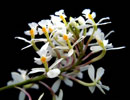
Pod Parent Flowers |
Click to Enlarge

Pollen Parent Flowers |
Click to Enlarge
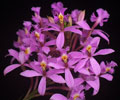
Offspring 'Vice' Flowers |
Click to Enlarge
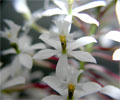
Offspring 'White Beauty' Flower |
Click to Enlarge
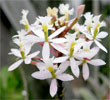
Offspring 'Pure White' Inflorescence |
Click to Enlarge

Offspring 'White' Inflorescence |
Click to Enlarge

Offspring 'Pinkish' Flowers |
Click to Enlarge
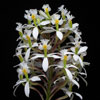
Offspring 'Versa' Inflorescence |
Click to Enlarge
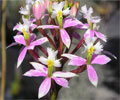
Offspring 'Splash' Flowers |
| Offspring photos are siblings of the plants you would receive. |
|
|
|
| |
Culture Notes from Donor: Parent plants: Temperature range I (60-83°F)
Comments: 'Swanson' is a much smaller and less robust plant than 'Meyers' although equally floriferous
Pollen parent plant: This is a very vigorous cultivar of the species.
For additional origin/habitat information supplied courtesy of
Charles and Margaret Baker, see further below, near the bottom of this page.
|
Temperatures we attempt to use in the lab & greenhouse:
| For Species: |
|
Spring, Summer, Autumn, Winter: days average 65°F, nights 44°F; best fit is Cool-Cold 64-44°F
(Source:
Baker's Web OSC) |
|
About the name...
| Etymology of |
Epidendrum |
|
From Greek "epi" upon; "dendron" tree.
(Source:
Pridgeon 1992) |
| Etymology of |
secundum |
|
From Latin "secundus" (blooming) one-sided. The flowers all point in one direction.
(Source:
Mayr & Schmucker 1998) |
| Pronunciation of |
Epidendrum |
|
eh-pee-DEN-drum
(Source:
Pridgeon 1992) |
| Pronunciation of |
secundum |
|
se-KUN-dum
(Source:
Hawkes 1978) |
|
If you would like to direct someone to this web page, please copy and paste this URL into your email:
http://troymeyers.com/d?011683
| Flask Information |
| Availability: |
We have sold all of the flasks for this item. |
| You should: |
Consider getting individual plants or compots instead of a flask.
You can place a "Notify Flask Recipients" Request, and either we or a flask recipient may contact you when plants are available.
You may also place a "Notify Retries" Request, and if an identical pollination (the same parents) is done again, we'll let you know.
You may reserve a flask, but it's very unlikely you'll get one ...this could only happen if we found a flask that we didn't know we had. |
| Yield Estimate: |
270 plants (based on flask surveys done 03/26/2002 )
|
| Plantlet Sizes: |
From many flasks 25 - 50 mm plants (based on flask surveys done 06/10/2002 )
From one most recently surveyed flask 25 - 50 mm (06/10/2002)
|
|
You might also want to:
|
View the seed assay for this item.
View items of the same species.
View items of the same genus.
|
| Ordering Information |
| You are not currently logged in. |
|
You must be a registered user and be logged in to reserve a flask or place a notification request. Please log in:
|
|
|
|
|
|
| |
The origin/habitat information below is supplied courtesy of Charles and Margaret Baker
The following information is based on the name of the plant provided by the donor, and assumes that the name is correct. If the plant has been misidentified, then the following information may not be correct.
This text is copyrighted by the Bakers and may not be reproduced without permission.
ORIGIN/HABITAT: The American tropics, where it is common and wide-spread
from northern South America to Brazil. The Venezuelan habitat is used for
the following climate tables. Dunsterville (1979) associated different
plant types with different habitats so Growing Conditions are discussed
individually. The general descriptions of the other habitats indicate a
habitat as diverse as is found in Venezuela. In Brazil, plants grow in
hot, humid lowlands as well as the cooler, wetter, ocean-facing slopes of
the coastal mountains in the states of Rio de Janeiro, Santa Catarina, and
Rio Grande do Sul. In Ecuador, plants have been collected at numerous
locations throughout the country. It grows on trees and on the surface of
the ground on steep slopes in wet, low elevation, tropical forests or
mountain cloudforests at 3300-8200 ft. (1000-2500 m). In Peru, plants grow
in wet forests in the Departments of Cajamarca and Huanuco at 4600-10,500
ft. (1400-3200 m). They are usually found on open, rocky, clay banks of
road cuts and old landslides and only rarely on trees.
Dunsterville and Garay (1961) reported the occurrence of this species in
Venezuela as follows. "Generally very common in hilly or mountainous
country, such as open slopes of grass and fern above Junquito at 7000 ft.
[2150 m], Colonia Tovar-La Victoria road at 6500 ft. [1200 m] in low
scrub, or above el Hatillo (Oripoto) at 4000 ft. [1200 m] in light forest.
An orange-red variety occurs on the Choroní road at 5000 ft. [1450 m] In
very damp tall forest at El Volcán near Sanare, at 6000 ft., the white
variety grows high up in the trees as an epiphyte while the yellow variety
grows in the same area as a terrestrial where the forest gives way to open
grassland."
The wide distribution and extremely variable size, shape, and color of the
flowers help explain the lengthy list of synonyms.
Dunsterville (1979) described the habitat location, type, and elevation of
the various color forms of Epidendrum elongatum (E. secundum) as they
occur in Venezuela.
More about this information and the Bakers...
|
|
|
| |
|
|
|